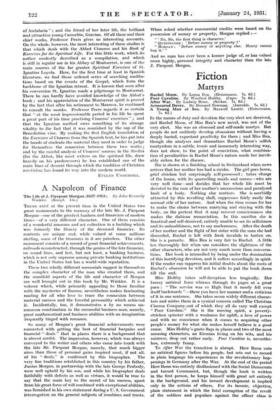Spanish Spirituality
Studies of the Spanish Mystics. Vol. I.I. E. Allison Peers, M.A. (S.P.C.K. 18s.) PROFESSOR ALLISON PEERS' devoted labours in the by-ways of Spanish mysticism place students of religious literature
ever more deeply in his debt. I say advisedly, students of literature ; for once we depart from the area illuminated by the great Carmelite saints, there is little to suggest that the lengthy and numerous works poured out by the Spanish ascetic writers of the sixteenth and seventeenth centuries owed much to first hand experience of the mystic life. Judged by comparison with the fourteenth century mystics of Italy, Germany or Flanders—or even with the best French teachers of the contemplative life—not one of the figures studied in Professor Peers' new volume can be put in the first class. Indeed, in order to bring some of them within his survey, he has been obliged to stretch the elastic term " mysticism " to a point at which it becomes -practically synonymous with religious fervour, and ignore the useful distinction between the ascetic and mystic lives.
The writers studied begin with the reforming Benedictine Abbot Cisneros, and end with Juan Falconi, the precursor of Molinos. They cover, therefore, the whole of the fifteenth and the early sixteenth centuries—the Ignatian, Teresan. and post-Teresan periods. Among them are three friends and advisers of St. Teresa, whose names are familiar to all students of her works ; the holy and ascetic Franciscan reformer, St. Peter of Aleantara, by whom she was deeply influenced at the beginning of her career, John of Avila, the " apostle of Andalucia " ; and the friend of her later life, the brilliant and attractive young Carmelite, Gracian. Of all these and their chief works, Professor Peers gives us interesting accounts. On the whole, however, the most interesting of these studies is that which deals with the Abbot Cisneros and his Book of Exercises for the Spiritual Life. For this, little work, which its author modestly described as a compilation, and which is still in regular use in his Abbey of Montserrat, is one of the main sources of the far greater Spiritual Exercises of St. Ignatius Loyola. Here, for the first time at least in Spanish literature, we find those ordered series of searching medita- tions based on the events of the Gospel, which form the backbone of the Ignatian retreat. It is known that soon after his conversion St. Ignatius made a pilgrimage to Montserrat. There he can hardly have avoided knowledge of the Abbot's book ; and his appreciation of the Montserrat spirit is proved by the fact that after his retirement to Manresa, he continued to consult the monks. Professor Peers regards it as certain that " at the most impressionable period in his life he spent a great part of his time practising Cisneros' exercises " ; and that the Ignatian method owes something of its strange vitality to the fact that it was nourished by the sap of the Benedictine vine. By making the first English translation of the Exercises of Cisneros from the Spanish text, he has put into the hands of students the material they need in order to judge for themselves the connexion between these two works ; and by the careful analysis of Cisneros' sources in the Studies (for the Abbot, like most writers on the spiritual life, drew heavily on his predecessors) he has established one of the main lines of descent through which the tradition of Christian asceticism has found its way into the modern world.
EVELYN UNDERIIILL.







































 Previous page
Previous page